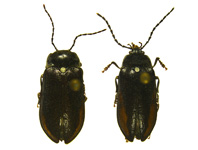Abstract
Pelomedusoides is the most diverse clade of side-necked turtles and there is an extensive fossil record (de Broin, 1988; Lapparent de Broin, 2000; Gaffney et al., 2006, 2011) that dates back at least to the Barremian (Lower Cretaceous) (Romano et al., 2014). Its large fossil record evidences a greater diversity in the past, particularly at the end of the Mesozoic, and exhibits a good sampling of species that are represented by skull material (Gaffney et al., 2006, 2011). As a consequence, the most complete and recent phylogenetic hypotheses for this clade (e.g. Romano et al., 2014; Cadena, 2015) are based on matrices comprising a great amount of cranial characters derived largely from Gaffney et al. (2006, 2011). In addition, it is well established that shell characters show a lot of phenotypic plasticity, even in the fossil species (Romano, 2008; Gaffney et al., 2006, 2011). In most cases it consequently is not justified to rely on “diagnostic features” of poorly informative shell-only material for describing a new species. Because of that, most authors remark new morphotypes in the literature when such aberrant specimens are recovered, but do not make any nomenclatural act by proposing a new yet poorly supported species (e.g. Romano et al., 2013; Ferreira & Langer, 2013; Menegazzo et al., 2015). Unfortunately, such a supposedly new bothremydid turtle (Pleurodira: Bothremydidae) from the Early Paleocene of Brazil was recently described based on poorly diagnostic remains (Carvalho et al., 2016; hereafter CGB, for the authors initials) and a correction of this unfounded nomenclatural act is required. In addition I present some comments on shell only material from Brazil in order to guide splitter-taxonomists to stop describing poorly preserved fossil specimens as new species.
References
Cadena, E. (2015) A global phylogeny of Pelomedusoides turtles with new material of Neochelys franzeni Schleich, 1993 (Testudines, Podocnemididae) from the middle Eocene, Messel Pit, of Germany. PeerJ, 3:e1221.
http://dx.doi.org/10.7717/peerj.1221Carvalho, A.R.A., Ghilardi, A.M. & Barreto, A.M.F. (2016) A new side-neck turtle (Pelomedusoides: Bothremydidae) from the Early Paleocene (Danian) Maria Farinha Formation, Paraíba Basin, Brazil. Zootaxa, 4126 (4), 491–513.
http://dx.doi.org/10.11646/zootaxa.4126.4.3de Broin, F. (1988) Les tortues et le Gondwana. Examen des rapportsentre le fractionnement du Gondawana et la dispersion géographiquedes tortues pleurodires à partir du Crétacé. Studia Geologica Salmanticensia, Studia Palaeocheloniologica, 2, 103–142.
Evenhuis, N.L. (2008) A Compendium of Zoological Type Nomenclature: a Reference Source. Bishop Museum Technical Report, 41, 1–23.
Ferreira, G.S. & Langer, M.C. (2013) A pelomedusoid (Testudines, Pleurodira) plastron from the Lower Cretaceous of Alagoas, Brazil. Cretaceous Research, 46, 267–271.
http://dx.doi.org/10.1016/j.cretres.2013.10.001Gaffney, E.S., Tong, H. & Meylan, P.A. (2006) Evolution of the side-necked turtles: the families Bothremydidae, Euraxemydidae, and Araripemydidae. Bulletin of the American Museum of Natural History, 300, 1–700.
http://dx.doi.org/10.1206/0003-0090(2006)300[1:EOTSTT]2.0.CO;2Gaffney E.S., Meylan, P.A., Wood, R.C., Simons, E. & Campos, D.D. (2011) Evolution of the side-necked turtles: the family Podocnemididae. Bulletin of the American Museum of Natural History, 350, 1–237.
http://dx.doi.org/10.1206/350.1Lambertz, M. & Perry, S.F. (2016) Again on the meaning of categorial ranks in modern evolutionary biology? Organisms, Diversity & Evolution, 16 (4), 723–725.
http://dx.doi.org/10.1007/s13127-016-0295-1Lapparent de Broin, F. (2000) The oldest pre-Podocnemidid turtle (Chelonii, Pleurodira), from the Early Cretaceous, Ceara State, Brasil, and its environment. Threeballs del Museu of Geologia de Barcelona, 9, 43–95.
Menegazzo, M.C., Bertini, R.J. & Manzini, F.F. (2015) A new turtle from the Upper Cretaceous Bauru Group of Brazil, updated phylogeny and implications for age of the Santo Anastácio Formation. Journal of South American Earth Sciences, 58, 18–32.
http://dx.doi.org/10.1016/j.jsames.2014.12.008Oliveira, G.R. & Kellner, A.W.A. (2007) Taxonomic status of Araripemys "arturi" Fielding, Martill & Naish, 2005 (Testudines, Pleurodira, Araripemydidae). In: Carvalho, I.S., Cassab, R.C.T., Schwanke, C., Carvalho, M.A., Fernandes, A.C.S., Rodrigues, M.A.C., Carvalho, M.S.S., Arai, M. & Oliveira, M.E.Q. (Eds), Paleontologia: Cenários de Vida, Volume 1. Interciência, Rio de Janeiro, pp. 393–399.
Oliveira, G.R., Rezende, J.S., Figueiredo, C.M., Azevedo, S.A.K. & Campos, D.A. (2015) An almost complete side-necked turtle shell (Pelomedusoides, Bothremydidae) from the Maria Farinha Formation (Paleogene, Paleocene), Paraíba Basin, NE Brazil. PeerJ PrePrints 3: e1133.
https://doi.org/10.7287/peerj.preprints.918v1Oliveira, G.R. & Romano, P.S.R. (2007) Histórico dos achados de tartarugas fósseis do Brasil. Arquivos do Museu Nacional, 65 (1), 113–131.
Rabi, M. & Sebők, N. (2015) A revised Eurogondwana model: Late Cretaceous notosuchian crocodyliforms and other vertebrate taxa suggest the retention of episodic faunal links between Europe and Gondwana during most of the Cretaceous. Gondwana Research, 28, 1197–1211.
http://dx.doi.org/10.1016/j.gr.2014.09.015
Rhodin, G.J. & Mittermeier, R.A. (1977) Neural Bones in Chelid Turtles from Australia and New Guinea. Copeia, 2, 370–372.
Romano, P. (2008) An unusual specimen of Bauruemys elegans and its implications for the taxonomy of the side-necked turtles from Bauru Basin (Upper Cretaceous of Brazil). Journal of Vertebrate Paleontology, 28 (3), 133A–134A.
Romano, P.S.R. & Azevedo, S.A.K. (2007) Morphometric analysis of the Upper Cretaceous Brazilian side-necked turtle Bauruemys elegans (Suárez, 1969) (Pleurodira, Podocnemididae). Arquivos do Museu Nacional, 65, 395–402.
Romano, P.S.R., Oliveira, G.R., Azevedo, S.A.K., Kellner, A.W.A. & Campos, D.A. (2013) New Information about Pelomedusoides (Testudines: Pleurodira) from the Cretaceous of Brazil. In: Brinkman, D.B., Holroyd, P.A., Gardner, J.D. (Eds), Morphology and Evolution of Turtles. Springer (Vertebrate Paleobiology and Paleoanthropology Series), New York, pp. 261–275.
http://dx.doi.org/10.1007/978-94-007-4309-0_16Romano, P.S.R., Gallo, V., Ramos, R.R.C. & Antonioli, L. (2014) Atolchelys lepida, a new side-necked turtle from the Early Cretaceous of Brazil and the age of crown Pleurodira. Biology Letters, 10, 20140290.
http://dx.doi.org/10.1098/rsbl.2014.0290Wood, R.C. (1984) Evolution of the pelomedusid turtles. Studia Geologica Salmanticensia, Studia Palaeocheloniologica, 1, 269–281.

